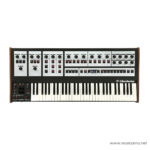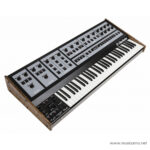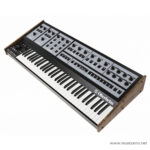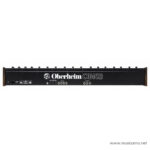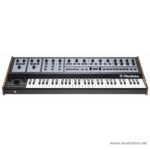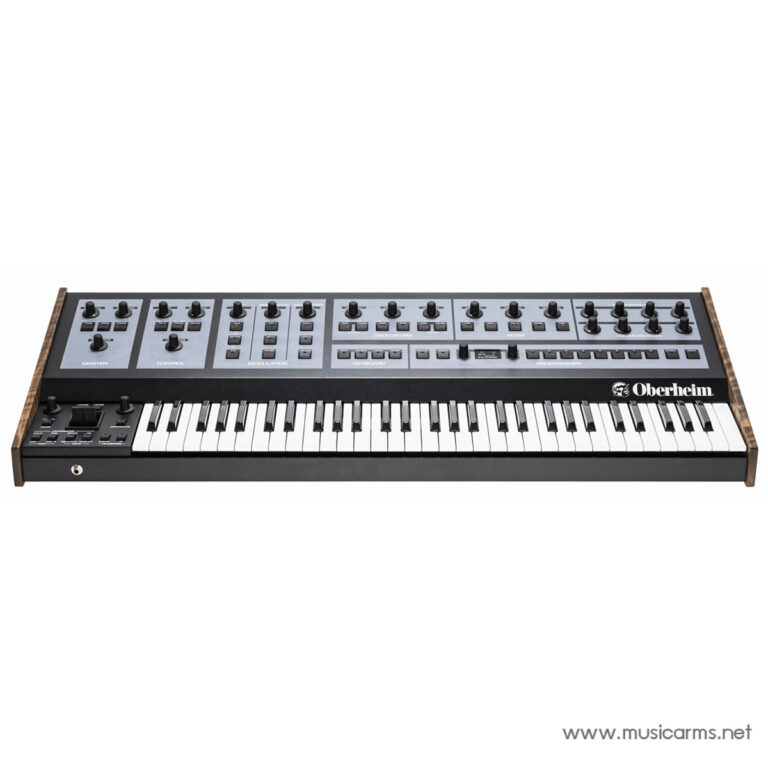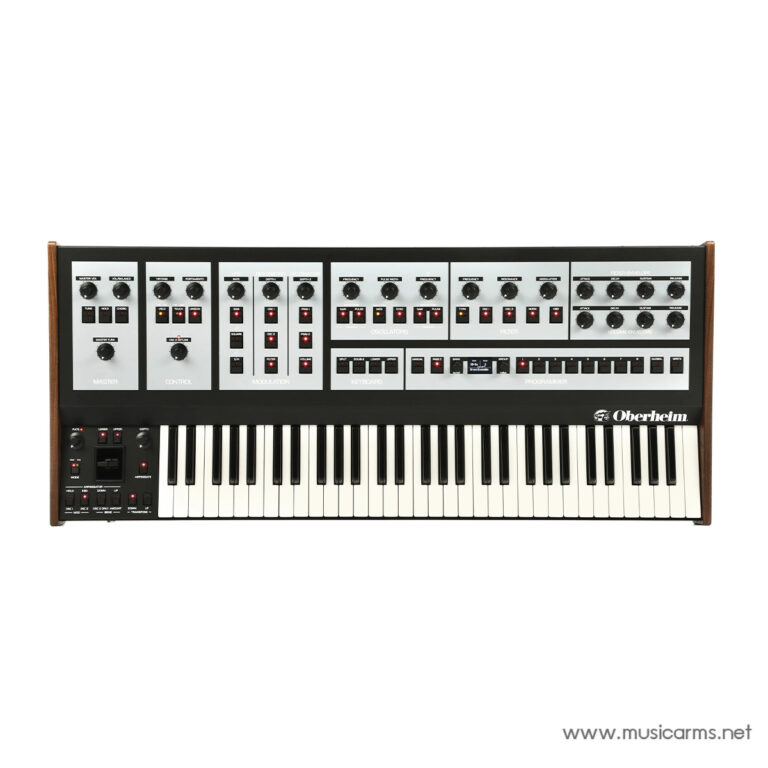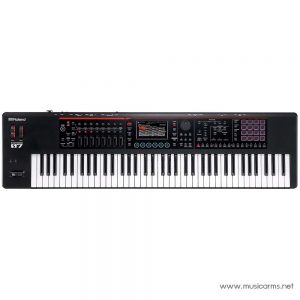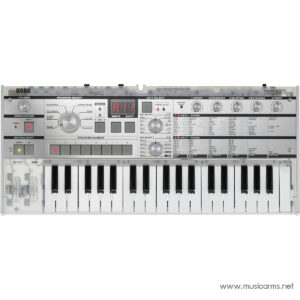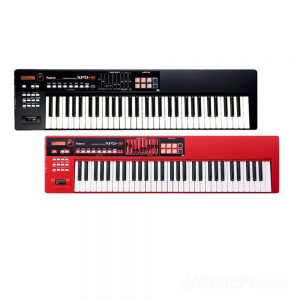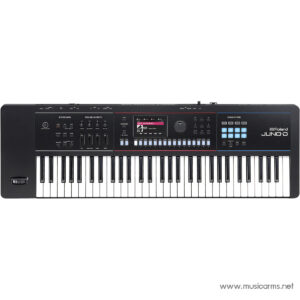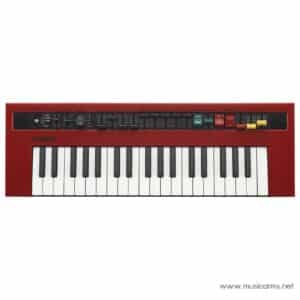Oberheim OB-X8

ราคา : 299,000 บาท
ลูกค้าองค์กร/ใบเสนอราคา
E-mail: musicarmsproject@gmail.com


- วีดีโอ
วีดีโอ

- Description
- Specification
- ข้อมูล
Description
Specification
ข้อมูล
Oberheim OB-X8
การกลับมาของโอบูร์ไฮม์ที่ยิ่งใหญ่!
ชื่อโอบูร์ไฮม์เป็นที่รู้จักกันดีในวงการซินเธไซเซอร์เสียง โดยผู้ก่อตั้ง ทอม โอบูร์ไฮม์ ถือเป็นหนึ่งในบุคคลที่มีอิทธิพลมากที่สุดในประวัติศาสตร์ของอุตสาหกรรมดนตรี เกือบสี่ทศวรรษหลังจากเครื่องดนตรีของโอบูร์ไฮม์ที่ถูกผลิตออกมาอย่างเป็นทางการครั้งสุดท้าย ผู้ผลิตยักษ์ใหญ่ได้กลับมาอีกครั้ง โดยมีโอบูร์ไฮม์เองเป็นผู้นำการเดินเรือ การกลับมาฉลองนี้คือซินเธไซเซอร์ OB-X8 แบบพอลิโฟนิกที่มีเสียงอนาล็อก ซึ่งมีการยกย่องรุ่น OB ที่มีชื่อเสียง โดยการสร้างแบบจำลองสามรุ่นในเครื่องซินเธไซเซอร์เดียว การรวมฟีเจอร์หลักทั้งหมดของ OB-X, OB-Xa, และ OB-8 ทำให้ OB-X8 มาพร้อมกับเสียงที่น่าจดจำและโดดเด่นที่สุดในยุค 80 อย่างครบถ้วน พร้อมด้วยประเภทฟิลเตอร์ที่แตกต่างและพรีเซ็ตทั้งหมดที่ทำให้แต่ละรุ่นโดดเด่น เครื่องมีเส้นทางสัญญาณอนาล็อกทั้งหมดซึ่งทำให้ OB-X8 มีความอบอุ่นและสมบูรณ์เสียงไม่ต่างจากรุ่นก่อน ด้วยส่วนที่มีป้ายกำกับซึ่งมีปุ่มและปุ่มหมุนที่สัมผัสได้สำหรับการควบคุมเสียงที่ง่ายและครบถ้วน คีย์บอร์ด FATAR ขนาด 61 คีย์ของมันมีความไวต่อแรงกดและสัมผัส ทำให้มีตัวเลือกที่ไม่มีที่สิ้นสุดสำหรับการเล่นที่แสดงออก และแม้ว่า OB-X8 จะเป็นซินเธไซเซอร์ “คลาสสิก” แต่การปรับปรุงในรูปแบบของหน้าจอ OLED และความเข้ากันได้ MIDI/USB ทำให้มันเป็นการเพิ่มที่สมบูรณ์แบบสำหรับอุปกรณ์ของซินเธสิสต์ทุกคน ห้ามพลาดการกลับมาที่รอคอยมายาวนานของหนึ่งในเสาหลักของการออกแบบและนวัตกรรมในโลกซินเธไซเซอร์!
ซีรีย์ OB ของโอบูร์ไฮม์: ครองอากาศตั้งแต่ปี ’79
ในขณะที่ผู้ที่ไม่เคยเล่นหรือสัมผัสกับโอบูร์ไฮม์แบบส่วนตัวอาจไม่รู้จัก แต่ใครก็ตามที่ฟังวิทยุในช่วงสี่ทศวรรษที่ผ่านมาน่าจะเคยได้ยินเสียงของเครื่องดนตรีที่ไม่สามารถจำผิดได้เหล่านี้ เมื่อเป็นการเสนอขายครั้งแรกในซีรีย์ OB ซินเธไซเซอร์ OB-X แบบพอลิโฟนิกขายออกไปประมาณ 800 เครื่องระหว่างปี 1979–1981 อย่างไรก็ตาม ซินเธไซเซอร์เหล่านี้ได้ไปอยู่ในมือของผู้สร้างดนตรีที่ได้รับความนิยมในยุคนั้น รวมถึงวง Rush ในอัลบั้ม Moving Pictures และ Signals, เดนนิส เดอยอง จาก Styx, มาดอนนา, และแม้แต่พรินซ์ การแทนที่ OB-X ในเวลาสองปีถัดมา คือ OB-Xa ซึ่งปรับปรุง OB-X ด้วยการอัปเกรดที่น่ายินดีและทำให้การตั้งค่าทำได้ง่ายขึ้น ซินเธไซเซอร์นี้เป็นที่รู้จักจากการเปิดตัวของเพลง “Jump” ของ Van Halen และปรากฏอยู่ในผลงานของ New Order, Queen, The Police และอื่น ๆ อีกมากมาย เมื่อ OB-8 แทนที่ OB-Xa ในปี 1983 อิทธิพลของโอบูร์ไฮม์ในดนตรีได้ขยายไปถึงดวงดาว โดยศิลปินเช่น อลิส โคลเทรน, Boyz Noise, Depeche Mode, Kool & The Gang และอีกมากมายใช้ซินเธไซเซอร์เป็นส่วนสำคัญของเสียงของพวกเขา
เสียงและความรู้สึกของโอบูร์ไฮม์ที่ถูกต้องพร้อมฟังก์ชันการทำงานที่เพิ่มขึ้น
หนึ่งในปัจจัยหลักที่ทำให้ OB-X8 มีความแม่นยำสูงสุดต่อซีรีย์ OB คือเส้นทางเสียงอนาล็อกทั้งหมด นี่คือปัจจัยที่ทำให้เกิดเสียงที่มีพลังและลักษณะเสียงของซินเธไซเซอร์ในคลาสสิกอย่าง “1999” ของพรินซ์ และ “Tom Sawyer” ของวง Rush นี่ไม่ใช่เพียงการสร้างใหม่หรือการคัดลอกมาตรฐาน — จากส่วนประกอบเองไปจนถึงการโต้ตอบที่แท้จริงระหว่างส่วนประกอบเหล่านั้น ทุกอย่างถูกวิเคราะห์อย่างพิถีพิถันเพื่อให้เกิดความสมจริงในระดับ 1:1 ส่งผลให้เกิดซินเธไซเซอร์ที่มีพลังซึ่งให้เสียงและการตอบสนองของสามโมเดลที่โดดเด่นในเครื่องเดียว แฟน ๆ ของฟังก์ชัน “Page 2” ที่หลากหลายของ OB-8 จะพบว่ามีมากมายที่ชื่นชอบใน OB-X8 ซึ่งมีพารามิเตอร์คลาสสิกทั้งหมดควบคู่ไปกับพารามิเตอร์ใหม่สำหรับทุกอย่างตั้งแต่การเข้าถึงโหมดฟิลเตอร์ SEM เพิ่มเติมไปจนถึงการติดตามคีย์บอร์ด LFO, การควบคุมความกว้างพัลส์อิสระ และอีกมากมาย
การควบคุมที่ง่ายดายและไม่สามารถวางมือได้
แม้ว่าตอนแรกชุดควบคุมของ OB-X8 จะดูเยอะจนทำให้รู้สึกท่วมท้น แต่อย่างไรก็ตาม Oberheim ได้ออกแบบ OB-X8 มาเพื่อให้ทั้งผู้ใช้งานใหม่และผู้มีประสบการณ์สามารถสัมผัสกับเวทมนตร์แห่งเสียงได้อย่างง่ายดายที่สุด ทุกอย่างถูกจัดแบ่งเป็นส่วนที่มีฟังก์ชันเฉพาะ โดยมีปุ่มและลูกบิดที่สามารถสัมผัสได้ง่ายเพื่อช่วยในการควบคุมอย่างราบรื่นในทุกส่วน ส่วนควบคุมหลัก (Master Section) ควบคุมระดับเสียงและความสมดุล เพื่อให้สามารถตั้งค่าการเล่นแบบ Splits และ Doubles ได้ พร้อมฟังก์ชันการจำคอร์ด, การจูนเสียง และการตั้งค่าการกดค้างของโน้ต เมื่อไปยังส่วนควบคุม (Control Section) คุณจะพบกับตัวเลือกการเบี่ยงเบนเสียงของ Oscillator 2 รวมถึงปุ่ม Vintage ซึ่งมีผลต่อการเปลี่ยนแปลงของ Envelopes, Oscillators และฟิลเตอร์ให้มีความหลากหลายตามแบบเครื่องดนตรีวินเทจ
ส่วนควบคุมการปรับแต่งเสียง (Modulation) มี 6 รูปแบบคลื่นที่แตกต่างกันและสามารถกำหนดเส้นทาง LFO ไปยังปลายทางต่างๆ ได้หลากหลาย ทำให้คุณสามารถสร้างเสียงกรองแบบฟิลเตอร์สวีพ (Filter Sweep), เสียงไวบราโต, เทรโมโล และเอฟเฟกต์สร้างสรรค์อื่นๆ ได้ ส่วน Oscillators จะปรับแต่งเสียงพื้นฐานของ OB-X8 โดยมีสอง Oscillators ต่อเสียงหนึ่งเสียง (Voice) ในแบบ SEM/OB-X พร้อมตัวเลือกคลื่นรูป Sawtooth, Pulse และ Triangle ส่วนของคีย์บอร์ดรองรับความสามารถ Bi-timbral ซึ่งถือเป็นหนึ่งในคุณสมบัติการเล่นที่น่าประทับใจที่สุดของ OB-X8 ที่สามารถกำหนดการตั้งค่าที่แตกต่างกันให้กับพื้นที่ต่างๆ บนคีย์บอร์ดได้ อีกทั้งยังมีตัวควบคุมจำนวนมากเพื่อให้คุณสามารถปรับแต่งทุกอย่างได้ตามต้องการ ส่วนของฟิลเตอร์ (Filter Section) เป็นที่ที่เสียงของ Oberheim จะได้เปล่งประกาย โดยมีการกำหนดค่าฟิลเตอร์อะนาล็อกสามแบบที่นำมาจากรุ่น OB-X, OB-Xa และ OB-8 ส่วน Envelopes จะมีฟังก์ชันปรับแต่งเสียงฟิลเตอร์และความดังสี่ขั้นตอน ที่จะช่วยให้คุณสร้างสรรค์เสียงได้ตั้งแต่เสียงเบาที่ละเอียดอ่อนไปจนถึงเสียงที่กึกก้องเหมือน “Hallelujah Chorus” ด้วยการหมุนลูกบิดไม่กี่ครั้ง
สำหรับผู้ที่ชอบบันทึกเสียงที่ชื่นชอบไว้เพื่อเรียกใช้ทันที ฟังก์ชัน Programmer จะกลายเป็นอาวุธลับของคุณ ช่วยให้คุณสามารถบันทึกและเลือกเสียงที่ตั้งไว้ล่วงหน้า รวมถึงเข้าถึงการตั้งค่าระดับโลกเพื่อปรับแต่งเสียงให้ลึกขึ้นไปอีก นอกจากนี้ยังมี Levers ที่สามารถตั้งโปรแกรมได้เพื่อตั้งค่าสำหรับไวบราโตและการปรับแต่งอื่นๆ พร้อมฟังก์ชัน Bend Box ที่ให้ LFO ตัวที่สองเพื่อควบคุม Mod Lever การเล่นอาร์เพจจิโอแบบเลื่อน (Sweeping Arpeggios) และท่อนดนตรีซับซ้อนทำได้ง่ายด้วยส่วนควบคุม Arpeggiator ของ OB-X8 โดยมีหน้าจอ OLED แสดงข้อมูลโปรแกรมและฟังก์ชันขั้นสูง “Page 2” OB-X8 ให้คุณสมบัติความหลากหลายของเสียงและตัวเลือกในการปรับแต่งที่ดนตรีทุกประเภทต่างต้องการ – ขอให้โชคดีกับการหยุดใช้เครื่องนี้หลังจากคุณได้ลองแล้ว!
ฟิลเตอร์สามชนิดที่หอมหวานจากประวัติศาสตร์ของ Oberheim
เมื่อใครก็ตามที่พูดถึง Oberheim ว่ามี “เสียงนั้น” เป็นไปได้อย่างมากว่านั่นเป็นผลมาจากการกำหนดค่าฟิลเตอร์คุณภาพสูงที่พบในผลิตภัณฑ์คลาสสิกของพวกเขา OB-X8 มาพร้อมกับฟิลเตอร์อะนาล็อกสามตัว โดยแต่ละตัวถูกนำมาจากแต่ละรุ่นที่ OB-X8 จำลองมา ฟิลเตอร์แบบ 2-Pole Lowpass จากรุ่น OB-X ที่มีต้นกำเนิดจาก SEM ส่งมอบเสียงที่หนาแน่นและหนักแน่น พร้อมการเพิ่มโหมดต่างๆ จากการออกแบบ SEM ดั้งเดิม ฟิลเตอร์ CEM3320 ที่ออกแบบโดย Doug Curtis และพบได้ใน OB-Xa และ OB-8 ก็มีใน OB-X8 ด้วย โดยมีตัวเลือกทั้งแบบ 2-Pole และ 4-Pole ที่เป็นแหล่งเสียงหลักที่ทำให้เกิดเสียงที่เป็นเอกลักษณ์ของซินธ์รุ่นนี้
ถูกนำโดยตำนานแห่งซินธิไซเซอร์ที่ยังมีชีวิตอยู่
Tom Oberheim มีรอยประทับที่ไม่สามารถปฏิเสธได้ในอุตสาหกรรมดนตรี ก่อนที่เขาจะออกแบบและพัฒนาเครื่องดนตรีที่เป็นที่จดจำมากที่สุดในยุค 1980s ความรักของ Tom ที่มีต่อแจ๊สนำเขามาลอสแอนเจลิสในปี 1956 โดยมีเพียง $10 ในกระเป๋า หลังจากศึกษาในสาขาวิศวกรรมคอมพิวเตอร์ ฟิสิกส์ และดนตรีที่ UCLA รวมถึงการทำงานในกองทัพสหรัฐฯ บริษัทเครื่องดนตรีแห่งชิคาโก (Chicago Musical Instruments Company) ก็สนใจในดีไซน์ตัวดัดแปลงวงแหวน (Ring Modulator) ที่ก้าวล้ำของ Tom ผลกระทบจากความคิดสร้างสรรค์และความเชี่ยวชาญทางอิเล็กทรอนิกส์ของเขาแพร่ขยายไปทั่ววงการ และในปี 1969 Oberheim Electronics ก็ได้ก่อตั้งขึ้น
พบกับทีมงานผู้อยู่เบื้องหลัง OB-X8
ด้วยประสบการณ์การออกแบบและวิศวกรรมที่ยาวนานเป็นทศวรรษ ไม่แปลกใจเลยที่ Tom Oberheim จะใช้ทีมงานที่มีความสามารถสูงสุดในการนำแบรนด์ Oberheim กลับมาแนะนำให้โลกได้รู้จักอีกครั้ง นอกจาก Tom แล้ว OB-X8 ยังได้รับการออกแบบโดย Marcus Ryle, Tony Karavidas, Dave Smith และทีมงานที่ยอดเยี่ยมจาก Sequential — เหล่านักดนตรีและแฟน ๆ อุปกรณ์ก็รู้จักและยกย่องทีมงานกลุ่มนี้อย่างรวดเร็วในฐานะผู้ขับเคลื่อนอุตสาหกรรมดนตรีมาอย่างยาวนาน Ryle อดีตวิศวกรของ Oberheim เป็นที่รู้จักในฐานะผู้ร่วมก่อตั้ง Line 6 และโปรโตคอลเสียง ADAT Karavidas มีประวัติด้านวิศวกรรมฮาร์ดแวร์ที่โดดเด่น โดยเฉพาะการทำงานให้กับ Sequential และ Dave Smith Instruments ในตำแหน่งสำคัญ ปิดท้ายรายชื่อด้วย Smith ผู้ก่อตั้ง Sequential และเป็นผู้สร้าง Prophet-5 ซึ่งได้รับการยกย่องว่าเป็นซินธิไซเซอร์โพลีโฟนิกเชิงพาณิชย์ตัวแรกที่ควบคุมด้วยไมโครโปรเซสเซอร์ ด้วยทีมระดับออลสตาร์นี้อยู่เบื้องหลัง OB-X8, Oberheim จึงพร้อมเต็มที่ที่จะทวงคืนความยิ่งใหญ่ในวงการซินธิไซเซอร์อีกครั้ง
คุณสมบัติของ Oberheim OB-X8 8-voice Polyphonic Analog Synthesizer:
- ซินธิไซเซอร์อะนาล็อกแบบโพลีโฟนิก 8 เสียง ถือเป็นการกลับมาของ Oberheim กับเครื่องดนตรีชิ้นแรกในรอบ 35 ปี
- ซินธิไซเซอร์อะนาล็อก 3 แบบในเครื่องเดียว: Oberheim OB-X, OB-Xa และ OB-8
- VCO แบบ OB-X/SEM-lineage ที่แยกกัน 2 ตัวต่อ 1 เสียง และ VCF แบบ SEM-lineage ที่แยกกัน ให้เสียงและพลังตามแบบ Oberheim รุ่นวินเทจ
- ฟิลเตอร์ที่ออกแบบโดย Dave Curtis ให้คาแรคเตอร์แบบ OB-Xa และ OB-8
- โหมด SEM เพิ่มเติมสำหรับฟังก์ชัน Highpass, Bandpass และ Notch
- ปุ่ม Vintage ช่วยเพิ่มความหลากหลายของเสียงระหว่างเสียงต่อเสียง
- การตอบสนองของ Envelopes ถูกจำลองอย่างละเอียดสำหรับแต่ละรุ่น โดยมีการวิเคราะห์ส่วนประกอบและปฏิกิริยาระหว่างส่วนประกอบเพื่อความสมจริง 1:1
- คีย์บอร์ด FATAR 61 คีย์ รองรับการสัมผัสและแรงกด
- รองรับการเล่นแบบ Bi-timbral สามารถเล่น 2 เสียงพร้อมกัน
- รองรับการวางซ้อนเสียงสูงสุด 8 เสียงแบบ Unison
- การแพนเสียงแต่ละเสียงในสเตอริโอได้อย่างกว้างขวาง
- โมดูเลชันข้ามคลื่นแบบ Triangle ที่ปรับเปลี่ยนได้
- คันโยก Pitch และ Mod สำหรับการดัดโน้ต ไวบราโต และการเข้าถึง Arpeggiator
- มีพรีเซ็ตดั้งเดิมกว่า 400 เสียงจากรุ่นก่อน และพรีเซ็ตใหม่ๆ
- รองรับการตั้งค่าผู้ใช้มากกว่า 600 พรีเซ็ต
- หน้าจอ OLED แสดงข้อมูลโปรแกรมและเข้าถึงฟีเจอร์ขั้นสูง
- รองรับ MIDI และ USB เพื่อให้เข้ากันได้กับทุกการตั้งค่า
- ขอบด้านข้างทำจากไม้วอลนัทแท้
- สเปค
สเปค
ฮาร์ดแวร์
- พอลิโฟนิก 8 เสียงพร้อมรูปคลื่น sine, saw, square, triangle, และ noise
- ออสซิลเลเตอร์แบบดิสครีตจากสายพันธุ์ SEM สองตัวต่อเสียง มอบเสียงที่มีพลังคลาสสิกแบบ Oberheim
- ฟิลเตอร์แบบดิสครีตจากสายพันธุ์ SEM สร้างเสียงและบรรยากาศแบบ OB-X ที่แท้จริง
- ฟิลเตอร์ Curtis ที่แท้จริงให้ความมีสไตล์แบบ OB-Xa/OB-8
- โมเดลเอนเวโลปที่ถูกสร้างขึ้นอย่างพิถีพิถันตรงกับแต่ละโมเดล OB: OB-X, OB-Xa, และ OB-8
- คีย์บอร์ด FATAR ขนาด 61 คีย์ที่มีความไวต่อแรงกดและการสัมผัส มอบการแสดงออกและการตอบสนองที่ไม่มีใครเทียบได้
- ความสามารถในการ Bi-timbral ช่วยให้ใช้โปรแกรมสองชุดพร้อมกันเพื่อแบ่งหรือรวมเสียง
- โปรแกรมโรงงานกว่า 600 รายการ รวมถึงชุดเสียงโรงงานเต็มรูปแบบสำหรับ OB-X, OB-Xa, และ OB-8
- ระบบจ่ายไฟที่ไม่มีพัดลมและไม่มีฮีทซิงค์
- ขอบไม้จริงจากวอลนัท
- จอแสดงผล OLED ความละเอียดสูงช่วยในการจัดการแพตช์และเข้าถึงฟีเจอร์ขั้นสูงได้ง่าย
- เลเวอร์ Pitch และ Mod แบบคลาสสิกของ Oberheim ช่วยให้มีการเบนโน้ตและสั่นสะเทือนที่แสดงออก รวมถึงการเข้าถึงฟังก์ชันอาร์เพจจิออเตอร์
การปรับปรุง
- โหมดฟิลเตอร์ SEM เพิ่มเติมช่วยเพิ่มฟังก์ชัน high-pass, band-pass, และ notch ให้กับฟิลเตอร์ OB-X คลาสสิก
- ปุ่ม Vintage ช่วยให้ปรับปริมาณการเปลี่ยนแปลงระหว่างเสียงได้ เพื่อเลียนแบบพฤติกรรมของเครื่องดนตรีเก่า
- ความไวต่อแรงกดช่วยเพิ่มความแสดงออกในระดับเสียงและฟิลเตอร์
- Channel Aftertouch เพิ่มการมอดูเลตตามประสิทธิภาพในเวลาจริง
- โหมด unison ที่ได้รับการปรับปรุงช่วยให้สามารถซ้อนเสียงได้ตั้งแต่ 1-8 เสียง
- ความกว้างพัลส์ที่ปรับได้ต่อออสซิลเลเตอร์ช่วยให้เสียงมีมิติและเคลื่อนไหวมากขึ้น
- การพานตามเสียงที่สามารถโปรแกรมได้ช่วยให้มีการแสดงเสียงในสเตอริโอที่กว้างขึ้น
- ระดับออสซิลเลเตอร์และเสียงที่ปรับได้
- LFO ติดตามคีย์บอร์ดช่วยให้มีการเปลี่ยนแปลงในความเร็วของ LFO ต่อโน้ต
อินพุตและเอาต์พุต
- เอาต์พุตสเตอริโอ L/R และโมโน
- ช่องสำหรับปีกผีเสื้อ, sustain, filter, และอาร์เพจจิออเตอร์
- MIDI In, Out, Thru
- USB

